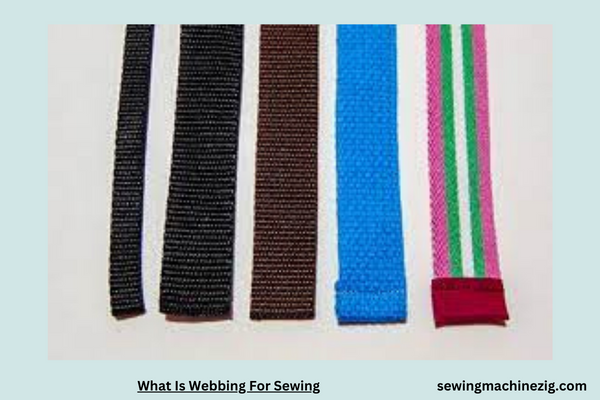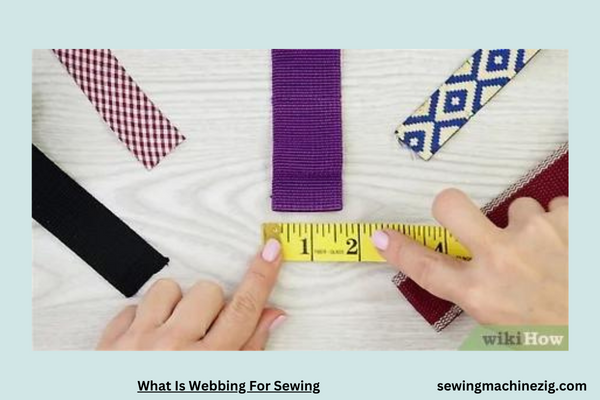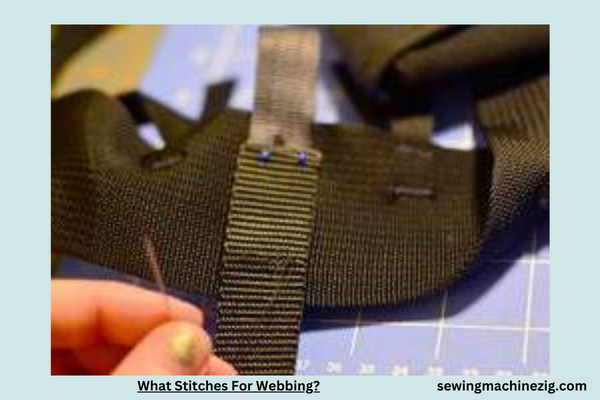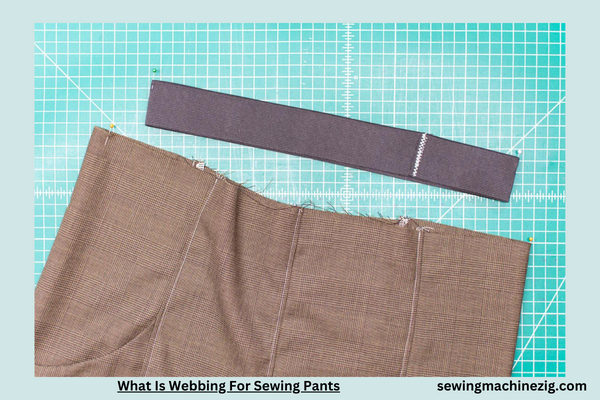
Embarking on a sewing adventure unveils a world of materials and accessories, and among them, webbing plays a crucial role. What Is Webbing For Sewing, you may wonder? This unassuming yet versatile material adds strength and structure to your creations, be it in crafting durable straps or reinforcing seams.
“What Is Webbing For Sewing, As we delve into the intricate tapestry of sewing, understanding the uses and types of webbing becomes paramount. Join me on this exploration, where we untangle the threads and discover how webbing weaves its way into enhancing both the strength and aesthetics of your sewing projects.
What Is Webbing For Sewing Detailed Answer

Embarking on a sewing journey often leads to the discovery of various materials that play crucial roles in crafting. One such essential component is webbing, a versatile material with a multitude of uses in the sewing realm. Let’s dive into an extensive step-by-step guide on “What Is Webbing For Sewing,” exploring its characteristics and applications:
Understanding Webbing:
- Webbing is a strong, woven fabric strip, often made from materials like nylon or polyester. Its durability and flexibility make it a go-to choice for various sewing projects.
Types of Webbing:
- Explore the different types of webbing available, including nylon webbing, polyester webbing, and cotton webbing. Each type possesses unique properties suited for specific applications.
Strength and Durability:
- Recognize the inherent strength and durability of webbing. Its robust nature makes it ideal for tasks that demand resilience, such as creating sturdy straps or reinforcing seams.
Choosing the Right Webbing:
- Consider the project at hand when selecting webbing. Nylon webbing excels in outdoor applications due to its water-resistant properties, while polyester offers excellent strength and UV resistance.
Width and Thickness Considerations:
- Assess the width and thickness of the webbing based on your project’s requirements. Thicker webbing adds strength, while narrower options may be suitable for more delicate applications.
Applications in Sewing:
- Delve into the myriad applications of webbing in sewing. From bag straps and belts to pet collars and outdoor gear, its versatility makes it a valuable addition to any sewing toolkit.
Stitching Techniques:
- Master stitching techniques when working with webbing. Utilize a heavy-duty needle and strong thread to ensure secure and durable seams, especially when dealing with high-tension areas.
Attaching Hardware:
- Learn how to attach hardware to webbing effectively. Whether it’s buckles, D-rings, or snaps, securing these elements properly enhances the functionality and aesthetics of your sewing projects.
Personalizing with Colors and Patterns:
- Explore the variety of colors and patterns available in webbing. Personalize your projects by selecting options that complement your overall design, adding a touch of style to functional elements.
Incorporating Elastic Webbing:
- Experiment with elastic webbing for projects that require a degree of stretch. This is particularly useful in applications like waistbands or areas that need flexibility.
Testing and Quality Assurance:
- Before incorporating webbing into your main project, conduct tests on scrap fabric to ensure compatibility with your sewing machine and to familiarize yourself with the material’s behavior.
Sourcing Quality Webbing:
- Invest in quality webbing from reputable suppliers. Quality ensures longevity, providing confidence that your sewing projects will withstand the test of time.
By following this comprehensive guide on “What Is Webbing For Sewing” you’ll unravel the potential of this versatile material. Let webbing be the strong, flexible thread that weaves functionality and durability into your sewing creations, elevating them from ordinary to extraordinary.
What Stitches For Webbing?

Let’s embark on a comprehensive step-by-step guide on “How To Darn With A Sewing Machine” while unraveling the intricacies of this essential material and its applications in the sewing realm:
Understanding Webbing:
Begin by grasping the fundamental concept of webbing. Webbing is a strong, woven fabric strip typically made from materials like nylon or polyester. It is renowned for its durability and is commonly used in various sewing projects for added strength and support.
Types of Webbing:
Explore the different types of webbing available for sewing. Common variations include nylon webbing, polyester webbing, cotton webbing, and polypropylene webbing. Each type has unique characteristics suitable for specific applications.
Applications in Sewing:
Recognize the versatile applications of webbing in sewing projects. It is widely used for creating straps, handles, belts, and reinforcement for various items such as bags, backpacks, dog collars, and outdoor gear.
Choosing the Right Webbing:
When selecting webbing for sewing, consider factors like the intended use, load-bearing requirements, and the overall aesthetic of your project. Nylon webbing is known for its strength and durability, while polyester webbing offers excellent resistance to UV rays.
Determining Width and Thickness:
Pay attention to the width and thickness of the webbing, as these factors influence its strength and suitability for specific applications. Thicker and wider webbing is often chosen for heavy-duty projects, while thinner options may be suitable for lighter items.
Matching Colors and Styles:
Enhance the visual appeal of your sewing projects by selecting webbing that complements the color and style of the fabric. Many webbing options come in a variety of colors, allowing you to coordinate with the overall design.
Preparing Webbing for Sewing:
Now, let’s seamlessly integrate the key phrase “How To Darn With A Sewing Machine” into the article. Before incorporating webbing into your sewing project, cut the desired length and seal the ends to prevent fraying. You can use methods like heat sealing, sewing, or applying fray check to ensure a neat and durable finish.
Attaching Webbing to Fabric:
Explore different methods for attaching webbing to fabric, including the innovative technique of “How To Darn With A Sewing Machine.” Common techniques include sewing, riveting, or using hardware such as buckles and D-rings for added functionality. Sewing webbing securely, especially with a sewing machine, is crucial for long-lasting results.
Reinforcing Stress Points:
Identify stress points in your sewing project where additional strength is needed. Use webbing to reinforce these areas, preventing wear and tear over time. This is especially important in items subjected to heavy loads or constant movement.
Creating Adjustable Straps:
Utilize webbing to craft adjustable straps for bags, backpacks, or other accessories. Incorporate hardware like sliders or adjuster buckles to allow users to customize the length of the straps according to their preferences.
Adding Decorative Elements:
Elevate the aesthetic appeal of your sewing projects by incorporating webbing as a decorative element, and experimenting with different weaving patterns or colors to create visually appealing and unique designs.
Maintaining Durability:
Prioritize durability when working with webbing and implementing the technique of “How To Darn With A Sewing Machine.” Ensure that your sewing techniques, thread choice, and reinforcement methods align with the strength requirements of the project to guarantee long-lasting results.
Exploring Specialty Webbing:
Be aware of specialty webbing options designed for specific purposes, such as seatbelt webbing for automotive projects or tubular webbing for climbing gear. Understanding these variations expands your choices for tailored applications.
Experimenting with Sewing Techniques:
Explore various sewing techniques when working with webbing, including straight stitches, bar tacks, or box stitches. The choice of technique depends on the specific requirements of your project and the type of webbing used.
Regular Maintenance and Inspection:
After completing your sewing project with webbing and utilizing the technique of “How To Darn With A Sewing Machine,” encourage users to perform regular inspections and maintenance. This proactive approach helps identify any signs of wear or damage, allowing for timely repairs and ensuring the continued functionality of the item.
By following these detailed steps on “What Is Webbing For Sewing” with the integration of “How To Darn With A Sewing Machine,” you’ll gain a comprehensive understanding of the material and its diverse applications in sewing projects.
Whether you’re crafting outdoor gear, bags, or accessories, incorporating webbing adds strength, durability, and a touch of creativity to your creations.
What Is Webbing For Sewing Pants

Let’s delve into a comprehensive step-by-step guide on “What Is Webbing For Sewing Pants,” unraveling the intricacies of this essential material and its applications in the realm of creating durable and stylish trousers:
Understanding Webbing:
To embark on the journey of sewing pants with finesse, grasp the fundamental concept of webbing. Webbing stands as a sturdy, woven fabric strip, commonly crafted from materials like nylon or polyester. In the context of sewing pants, webbing emerges as a versatile tool, strategically reinforcing and bestowing extra strength to specific areas.
Types of Webbing:
Venture into the diverse landscape of webbing suitable for sewing pants. Variations include nylon webbing, polyester webbing, cotton webbing, and polypropylene webbing. Each type boasts unique characteristics, contributing to the durability and functionality of pants.
Applications in Sewing Pants:
Recognize the multi-faceted applications of webbing when sculpting pants. Ingeniously incorporated into elements like belt loops, waistbands, and pocket reinforcements, webbing becomes the unsung hero, providing resilience to high-stress areas and ensuring the longevity of the garment.
Choosing the Right Webbing:
When selecting the ideal webbing for sewing pants, factors such as fabric weight, aesthetic preferences, and the garment’s intended purpose come into play. Nylon webbing takes the spotlight, celebrated for its robustness and durability—making it a stellar choice for reinforcing stress points in pants.
Determining Width and Thickness:
Navigate the dimensions of width and thickness in your chosen webbing, pivotal factors influencing its suitability for sewing pants. Opt for thicker and wider webbing for heavy-duty applications, while leaner options gracefully complement lighter-weight pants.
Matching Colors and Styles:
Elevate the visual harmony of your pants by meticulously selecting webbing that harmonizes with the fabric’s color and style. An array of colors in webbing options empowers you to seamlessly coordinate with the overarching design of your pants.
Preparing Webbing for Sewing Pants:
Before weaving webbing into your pants project, precision is key. Cut the desired lengths, sealing the ends to thwart fraying. This meticulous step ensures a polished finish, contributing to the professional allure of the final garment.
Attaching Webbing to Pants:
Embark on an exploration of diverse methods to seamlessly attach webbing to pants. Whether through adept sewing, riveting finesse, or the integration of hardware like buckles and D-rings, the secure attachment of webbing onto pants is paramount—especially in high-stress zones like belt loops.
Reinforcing Stress Points:
Identify stress points within your pants project that beckon for augmented strength. Webbing steps in as the vigilant guardian, reinforcing areas such as the waistband, belt loops, or pockets. This foresighted approach thwarts wear and tear over time, ensuring your pants endure the rigors of regular use.
Creating Adjustable Features:
Harness the versatility of webbing to fashion adjustable features in pants—be it drawstrings or adaptable waistbands. Infuse sophistication with hardware like sliders or adjuster buckles, seamlessly blending functionality and style.
Adding Decorative Elements:
Elevate the sartorial narrative of your pants by infusing webbing as a decorative muse. Embrace experimentation with diverse weaving patterns or contrasting colors, forging visually stunning and distinctive designs that leave an indelible impression.
Maintaining Durability:
Place durability at the forefront of your considerations when coalescing webbing with pants. Harmonize your sewing techniques, thread choices, and reinforcement methodologies with the robust demands of the pants, ensuring enduring results even in the face of frequent wear and washing.
Exploring Specialty Webbing:
Delve into the realm of specialty webbing, tailor-made for distinct purposes. Elastic webbing introduces stretchy waistbands, while reflective webbing elevates visibility in outdoor pants. A comprehensive understanding of these variations expands your arsenal for bespoke applications.
Experimenting with Sewing Techniques:
Embark on a journey of experimentation with diverse sewing techniques harmonizing with webbing in pants. Whether executing straight stitches, artful bar tacks, or sturdy box stitches, your choice hinges on the specific demands of your project and the character of the webbing employed.
Regular Maintenance and Inspection:
Culminate your pants project with webbing by instilling a culture of regular inspections and maintenance. This proactive approach empowers users to identify early signs of wear or damage, facilitating timely repairs and ensuring the sustained functionality and style of the pants.
By following these detailed steps on “What Is Webbing For Sewing Pants,” you not only garner a holistic understanding of the material but also wield its transformative potential in sculpting durable, functional, and stylish trousers. Whether reinforcing the resilience of belt loops or infusing artistic elements into pocket edges, webbing emerges as an invaluable ally, elevating the quality and longevity of your pants projects
Conclusion
In conclusion, delving into the world of webbing for sewing unravels a versatile material with myriad applications. Understanding its types, choosing the right webbing for specific projects, and mastering attachment techniques empower crafters to enhance the strength and aesthetics of their creations.
“What Is Webbing For Sewing” serves as a gateway to elevating sewing projects, whether reinforcing stress points in pants, crafting adjustable features, or adding decorative elements. Embrace the diverse possibilities of webbing for sewing to amplify the durability and style of your creations.
FAQS
Q: What is webbing, and how is it used in sewing projects?
A: Webbing is a strong, woven fabric strip, often made from materials like nylon or polyester, employed in sewing for added strength and support. In projects such as bags, backpacks, and outdoor gear, webbing is utilized to create straps, handles, and reinforcement, enhancing the durability of the final product.
Q: Are there different types of webbing for sewing, and how do I choose the right one?
A: Yes, various types of webbing are available, including nylon, polyester, cotton, and polypropylene. The choice depends on your project’s requirements, with nylon known for strength, polyester for UV resistance, and cotton for a natural feel. Select the one that aligns with your intended use and aesthetic preferences.
Q: Can webbing be used solely for decorative purposes in sewing?
A: Absolutely, webbing can serve decorative purposes in sewing projects. Experiment with different weaving patterns, colors, and styles to add visual appeal to items like bags or garments. The versatility of webbing extends beyond functionality, allowing for creative and unique design elements.
Q: How do I prepare and attach webbing to fabric in sewing projects?
A: Before incorporating webbing into a project, cut the desired length and seal the ends to prevent fraying. The attachment methods vary, including sewing, riveting, or using hardware like buckles. Sewing webbing securely is essential for durable results, especially in stress-prone areas. What Is Webbing For Sewing
Q: Can webbing be used to reinforce stress points in sewing projects?
A: Yes, webbing is excellent for reinforcing stress points in sewing projects. Identify areas like straps, belt loops, or pockets that undergo frequent stress and incorporate webbing to enhance durability. This proactive step prevents wear and tear over time, ensuring the longevity of the sewn item. What Is Webbing For Sewing



